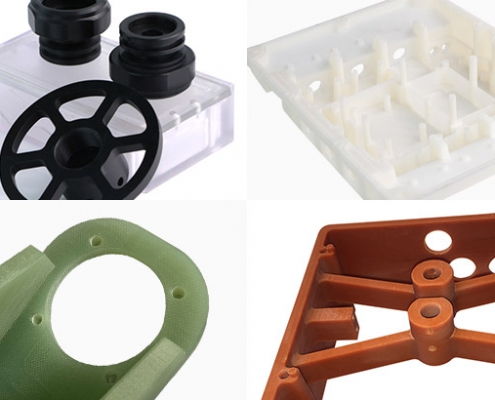A Comprehensive Guide: What Materials Cannot be Used in 3D Printing?
3D printing has opened new doors for manufacturing and prototyping, enabling rapid production of intricate designs. However, its capabilities come with material limitations. Using incompatible materials often leads to technical failures, wasted resources, and compromised safety. Knowing what cannot be used in 3D printing is essential to optimizing projects and ensuring success.
Certain materials, including high-temperature metals, reactive chemicals, and non-thermoplastics, are unsuitable for 3D printing. By understanding these limitations and their alternatives, you can expand your options and make informed decisions for your projects.
Let’s take a closer look at the materials that cannot be used, the reasons behind their incompatibility, and the solutions to overcome these challenges.
What is 3D Printing and How Does it Work?
3D printing is an additive manufacturing process that creates objects layer by layer from digital designs. Unlike traditional machining that removes material, 3D printing builds parts by depositing or solidifying materials such as plastics, resins, or metals.
The process starts with a 3D model, which is sliced into thin layers by software. The printer then follows these layers precisely, stacking them until the final object is formed. This allows for rapid prototyping, customization, and complex geometries.
What Materials Can Be Used in 3D Printing?
3D printing supports a diverse range of materials, each with unique properties suited for specific applications. From thermoplastics to metals, ceramics, and composites, these materials enable various industries to produce everything from prototypes to functional parts. Below is the most commonly used materials and their characteristics.
| Material Category | Specific Materials | Applications | Key Features |
|---|---|---|---|
| Thermoplastics | PLA, ABS, PETG, Nylon | Prototyping, household items, toys | Easy to print, low cost, durable |
| Resins | Standard, Tough, Flexible | Dental models, jewelry, figurines | High detail, smooth finish |
| Metals | Aluminum, Titanium, Steel | Aerospace, automotive, medical implants | High strength, lightweight, durable |
| Composites | Carbon Fiber, Glass Fiber | Automotive, sports equipment | Enhanced strength and rigidity |
| Ceramics | Alumina, Zirconia | Medical implants, heat-resistant parts | Heat resistance, biocompatibility |
| Flexible Materials | TPU, TPE | Phone cases, wearable devices | Elastic, impact-resistant |
What Materials Cannot Be Used in 3D Printing?
Not all materials are suitable for 3D printing due to their inherent chemical and physical limitations. The following materials cannot be used in 3D printing.
1. High-Melting-Point Metals
Materials like tungsten and titanium are unsuitable for 3D printing because they require extremely high temperatures to melt. Most 3D printers lack the necessary heat resistance and advanced technology to process these metals effectively. These limitations make alternative methods, such as CNC machining or industrial-grade sintering, more viable options for high-performance applications.

2. Reactive Chemicals
Highly reactive substances like sodium and peroxides are incompatible with 3D printing due to significant safety risks. When heated or extruded, these chemicals can ignite, release toxic gases, or cause dangerous reactions.
3. Non-Thermoplastics
Non-thermoplastic materials, such as polyester and epoxy, are unsuitable for 3D printing because they degrade or burn instead of melting when exposed to heat. These materials fail to meet the melting and extrusion requirements of most 3D printing processes, limiting their use in additive manufacturing.
4. Soft Materials
Soft materials, including uncured silicone and certain rubbers, do not possess the rigidity needed for proper layer adhesion during 3D printing. Without sufficient structural stability, these materials tend to deform or collapse, making them impractical for standard 3D printing methods.
Why High-Temperature Metals Are Unprintable?
3D printing metals such as stainless steel or aluminum is possible, but materials like tungsten are not commonly used. High-melting-point metals demand extreme heat or sintering technology that is unavailable in standard printers. CNC machining often becomes the preferred method for such applications because it can handle high-precision cuts and complex geometries.
What Plastics Are Unsuitable for 3D Printing?
Certain plastics cannot be 3D printed effectively. For example, UHMW has poor flow properties and tends to warp or degrade during the process. Similarly, some polyesters and can you 3D print with silicone queries highlight how materials without thermoplastic properties fail to perform. This makes them incompatible with extrusion-based techniques like FDM.
For applications requiring flexible materials, alternatives such as thermoplastic elastomers or advanced methods like liquid deposition modeling are better choices.

How Material Selection Depends on Printer Type?
Different types of printers, such as FDM, SLA, and SLS, have varying material compatibilities. For instance, multimaterial 3D printing allows combining polymers and composites but may not handle pure metals effectively. The material choice should align with both printer specifications and end-use requirements.
Applications and Materials for Everyday 3D Printing
Modern 3D printers can work with a wide range of materials, making them useful for many everyday and specialized applications:
- Everyday Items: Create functional and decorative objects such as coasters, toys, and personalized items like keychains. Seasonal designs, such as Halloween props or ornaments, are also popular and easy to produce.
- Specialized Tools: 3D printing is ideal for crafting tools and parts like screws, cable combs, or custom gears for repairs, electronics organization, or machinery upgrades.
- Home and Hobby Projects: Experiment with designs for things like 3D-printed lamps, phone stands, or even small furniture accessories.
- Advanced Applications: For industry or research, 3D printing supports prototypes of jet turbine parts, medical models like human hearts, and even functional components for drones or vehicles.
- Artistic and Personal Projects: Create unique designs like custom jewelry, art pieces, or even experimental items like 3D-printed instruments.
Can You 3D Print with Silicone?
Printing with silicone is a complex process. Standard 3D printers cannot handle silicone due to its non-thermoplastic nature. However, technologies like liquid deposition modeling have enabled the creation of silicone-based products such as 3d print lamp and other flexible designs.
In Conclusion
Material compatibility is a critical factor in 3D printing. By understanding the limitations of certain materials and exploring viable alternatives, you can optimize both the quality and performance of your printed parts.
If you need help with your 3D printing partner, VMT is a great choice. We offer a variety of materials, accurate printing, and expert support to make sure your parts come out just right. Whether you’re making a prototype or final product, VMT is here to help you every step of the way.
More Resources: How to Make Strong 3D Prints?
How to Finish 3D Printed Parts- A Study Guide
CNC vs 3D Printing: Which is Better for Your Parts Machining?
Frequently Asked Questions
Is there anything that cannot be 3D printed?
Yes, not everything can be 3D printed. Objects requiring extremely high precision, made from certain materials like diamonds or complex alloys, or with integrated electronics are challenging. Also, printing living tissues or food with consistent quality is still under development. Legal and ethical restrictions also limit printing certain items, like firearms.
Can you 3D print with any material?
No, 3D printing is limited to specific materials. Common materials include plastics like PLA, ABS, and resins, as well as metals like steel or titanium in advanced machines. However, materials like glass, ceramics, or certain composites require specialized technology. Some materials are incompatible with standard printers due to temperature or chemical constraints.
What materials are toxic in 3D printing?
Certain materials in 3D printing emit toxic fumes. ABS plastic, for instance, releases harmful VOCs during printing. Resins used in SLA printing can be toxic if not handled properly. Always work in a well-ventilated area, use protective equipment, and avoid direct skin contact with hazardous materials.



